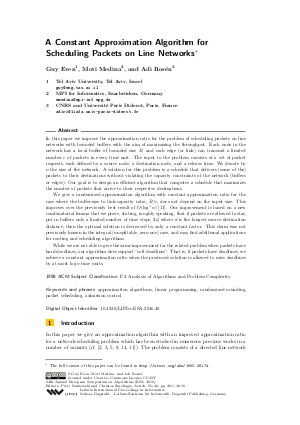A Constant Approximation Algorithm for Scheduling Packets on Line Networks
Authors Guy Even, Moti Medina, Adi Rosén
-
Part of:
Volume:
24th Annual European Symposium on Algorithms (ESA 2016)
Part of: Series: Leibniz International Proceedings in Informatics (LIPIcs)
Part of: Conference: European Symposium on Algorithms (ESA) - License:
 Creative Commons Attribution 3.0 Unported license
Creative Commons Attribution 3.0 Unported license
- Publication Date: 2016-08-18
File

PDF
LIPIcs.ESA.2016.40.pdf
- Filesize: 0.66 MB
- 16 pages
Document Identifiers
Subject Classification
Keywords
- approximation algorithms
- linear programming
- randomized rounding
- packet scheduling
- admission control
Metrics
- Access Statistics
-
Total Accesses (updated on a weekly basis)
0PDF Downloads0Metadata Views
Abstract
In this paper we improve the approximation ratio for the problem of scheduling packets on line networks with bounded buffers with the aim of maximizing the throughput. Each node in the network has a local buffer of bounded size B, and each edge (or link) can transmit a limited number c of packets in every time unit. The input to the problem consists of a set of packet requests, each defined by a source node, a destination node, and a release time. We denote by n the size of the network. A solution for this problem is a schedule that delivers (some of the) packets to their destinations without violating the capacity constraints of the network (buffers or edges). Our goal is to design an efficient algorithm that computes a schedule that maximizes the number of packets that arrive to their respective destinations. We give a randomized approximation algorithm with constant approximation ratio for the case where the buffer-size to link-capacity ratio, B/c, does not depend on the input size. This improves over the previously best result of O(log^* n) [Räcke and Rosén SPAA 2009]. Our improvement is based on a new combinatorial lemma that we prove, stating, roughly speaking, that if packets are allowed to stay put in buffers only a limited number of time steps, 2d, where d is the longest source-destination distance, then the optimal solution is decreased by only a constant factor. This claim was not previously known in the integral (unsplitable, zero-one) case, and may find additional applications for routing and scheduling algorithms. While we are not able to give the same improvement for the related problem when packets have hard deadlines, our algorithm does support "soft deadlines". That is, if packets have deadlines, we achieve a constant approximation ratio when the produced solution is allowed to miss deadlines by at most log n time units.
Cite As Get BibTex
Guy Even, Moti Medina, and Adi Rosén. A Constant Approximation Algorithm for Scheduling Packets on Line Networks. In 24th Annual European Symposium on Algorithms (ESA 2016). Leibniz International Proceedings in Informatics (LIPIcs), Volume 57, pp. 40:1-40:16, Schloss Dagstuhl – Leibniz-Zentrum für Informatik (2016)
https://doi.org/10.4230/LIPIcs.ESA.2016.40
BibTex
@InProceedings{even_et_al:LIPIcs.ESA.2016.40,
author = {Even, Guy and Medina, Moti and Ros\'{e}n, Adi},
title = {{A Constant Approximation Algorithm for Scheduling Packets on Line Networks}},
booktitle = {24th Annual European Symposium on Algorithms (ESA 2016)},
pages = {40:1--40:16},
series = {Leibniz International Proceedings in Informatics (LIPIcs)},
ISBN = {978-3-95977-015-6},
ISSN = {1868-8969},
year = {2016},
volume = {57},
editor = {Sankowski, Piotr and Zaroliagis, Christos},
publisher = {Schloss Dagstuhl -- Leibniz-Zentrum f{\"u}r Informatik},
address = {Dagstuhl, Germany},
URL = {https://drops.dagstuhl.de/entities/document/10.4230/LIPIcs.ESA.2016.40},
URN = {urn:nbn:de:0030-drops-63524},
doi = {10.4230/LIPIcs.ESA.2016.40},
annote = {Keywords: approximation algorithms, linear programming, randomized rounding, packet scheduling, admission control}
}
Author Details
References
- Micah Adler, Arnold L. Rosenberg, Ramesh K. Sitaraman, and Walter Unger. Scheduling time-constrained communication in linear networks. Theory Comput. Syst., 35(6):599-623, 2002. URL: http://dx.doi.org/10.1007/s00224-002-1001-6.
- William Aiello, Eyal Kushilevitz, Rafail Ostrovsky, and Adi Rosén. Dynamic routing on networks with fixed-size buffers. In SODA, pages 771-780, 2003. URL: http://dx.doi.org/10.1145/644108.644236.
- Stanislav Angelov, Sanjeev Khanna, and Keshav Kunal. The network as a storage device: Dynamic routing with bounded buffers. Algorithmica, 55(1):71-94, 2009. (Appeared in APPROX-05). URL: http://dx.doi.org/10.1007/s00453-007-9143-1.
-
Baruch Awerbuch, Yossi Azar, and Amos Fiat. Packet routing via min-cost circuit routing. In ISTCS, pages 37-42, 1996.

- Yossi Azar and Rafi Zachut. Packet routing and information gathering in lines, rings and trees. In ESA, pages 484-495, 2005. (See also manuscript in http://www.cs.tau.ac.il/~azar/). URL: http://dx.doi.org/10.1007/11561071_44.
- Guy Even and Moti Medina. An O(logn)-Competitive Online Centralized Randomized Packet-Routing Algorithm for Lines. In ICALP (2), pages 139-150, 2010. URL: http://dx.doi.org/10.1007/978-3-642-14162-1_12.
- Guy Even and Moti Medina. Online packet-routing in grids with bounded buffers. In Proc. 23rd Ann. ACM Symp. on Parallelism in Algorithms and Architectures (SPAA), pages 215-224, 2011. URL: http://dx.doi.org/10.1145/1989493.1989525.
-
Guy Even and Moti Medina. Online packet-routing in grids with bounded buffers. CoRR, abs/1407.4498, 2014.

- Guy Even, Moti Medina, and Boaz Patt-Shamir. Better deterministic online packet routing on grids. In Proceedings of the 27th ACM on Symposium on Parallelism in Algorithms and Architectures, SPAA 2015, Portland, OR, USA, June 13-15, 2015, pages 284-293, 2015. URL: http://dx.doi.org/10.1145/2755573.2755588.
-
Jon M Kleinberg. Approximation algorithms for disjoint paths problems. PhD thesis, Massachusetts Institute of Technology, 1996.

- Harald Räcke and Adi Rosén. Approximation algorithms for time-constrained scheduling on line networks. In SPAA, pages 337-346, 2009. URL: http://dx.doi.org/10.1145/1583991.1584071.
-
Prabhakar Raghavan. Randomized rounding and discrete ham-sandwich theorems: provably good algorithms for routing and packing problems. In Report UCB/CSD 87/312. Computer Science Division, University of California Berkeley, 1986.

-
Prabhakar Raghavan and Clark D Tompson. Randomized rounding: a technique for provably good algorithms and algorithmic proofs. Combinatorica, 7(4):365-374, 1987.

- Adi Rosén and Gabriel Scalosub. Rate vs. buffer size-greedy information gathering on the line. ACM Transactions on Algorithms, 7(3):32, 2011. URL: http://dx.doi.org/10.1145/1978782.1978787.
-
Neal E Young. Randomized rounding without solving the linear program. In SODA, volume 95, pages 170-178, 1995.

